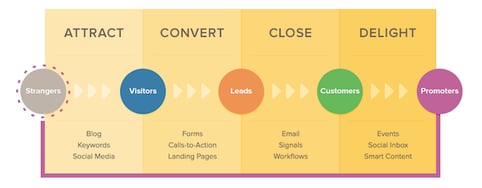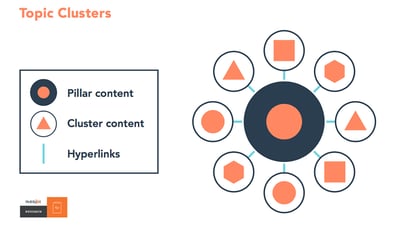
“SEO-First” content creation is a term that we’ve heard from a few of our clients lately. It usually refers to the practice of creating content that serves first and foremost to implement the SEO plan.
Some clients have seen great results with this approach. Should this be the “go to” approach for content creation for every SaaS company?
The answer is absolutely not.
In this article, we’ll attempt to explain when this approach makes sense and, more importantly, when it doesn’t.
First, let’s identify the alternative approach…
We refer to the alternative approach as “Inbound-First” content creation.
Here are the typical steps in such a process:
1. Identify the customer journey and all the buyer personas that participate in your journey. Then name each step of the journey.
 HubSpot Image
HubSpot Image
2. For every step of the journey identify topics that would be most valuable for your targeted personas to read about, learn about, and consume. This would typically include topics that educate those who are likely to become interested in your products at some stage. It would also cover your main stories and value propositions.
3. Prepare a marketing strategy plan by choosing your main goals and marketing channels, and identifying which content assets are needed in order to build your “lead generation machine”
4. Write the content with the best quality possible. “This is a no-brainer,” you think. But you need to remember, the content should aim as much as possible to help, interest, educate and impress your target audience.
5. Optimize the content for SEO by assigning the best fit keyword to the asset and applying all the meta-tagging, applying all the best practices in terms of performance and conversion optimization, and creating a foundation that will support an SEO linking structure.
Notice that in this process the SEO part comes last. When you prioritize it after content is written, it can also be applied to existing content (even to historical content).
Now let’s examine how content is created with the “SEO-First” approach…
1. Start with building an SEO strategy. The strategy is of course very important and needs to align with all of the company’s marketing goals. The strategy needs to include a topic cluster plan.

HubSpot Image
*In this blog I’m assuming you (the reader) know what that means. Here’s a webinar where you can learn how to build a topic cluster plan.
2. Prioritize your topic clusters and start generating pages. For every topic cluster, you should identify a “pillar” page. That page needs to be written applying all of the best practices to convince Google that this page is the most authoritative on the whole planet (for this specified search term). The pillar topic content needs to be extremely extensive, covering the topic better than any other page in the world (in the humble opinion of your target reader).
3. For every topic cluster, write an article for every search term that Google sees as a subtopic related to your main cluster topic.
4. Link your subtopics to your main topics, creating an internal linking structure on your site. This will create a giant Batman-size signal to show Google whose authority ranks highest for this topic.
5. Apply all the best practices to every page in order to optimize it to its full potential. This means optimizing tagging, performance, usability, etc.
The main difference between the two approaches is that in the first one the main driver or focus for what you write is serving the inbound marketing client journey, and in the second approach the focus is on implementing the topic clusters.
In both approaches, if they are well executed the results build up and your organic traffic rises beautifully!
So Which Approach Is Better?
The “SEO-First” approach is ideal for companies that have the “luxury” of having enough content to serve every step of their inbound journey. At this stage, they can begin optimizing their SEO without worrying about covering their base when “nurturing” their leads with relevant content to push them down the funnel.
Typically this is the status of companies that have a more mature marketing team, and have a content marketing budget that allows them to use a dedicated content writer, or outsource to an agency that writes content for them.
For companies that are not as mature in terms of content assets - I would recommend the “Inbound-First” approach. Anything else will de-focus your content creation efforts from the most important thing which is to build your “lead-gen-machine” with great content assets that can really bring in the right people and “nurture” them effectively pushing them to become clients.
In either approach - it is always super important to have an SEO strategy or a topic cluster plan prepared - so you can associate any article or web page with the right keyword and link it properly to create effective clusters.
It also makes sense to have a cluster plan ready early on - because it will help you choose urls for your website pages that support your cluster plan. The url of a page is not something you want to change over time because changing it will negatively impact your historical “credit” with the search engines.
Bottom line recommendation: Prepare a topic-cluster plan early on as you’re building your digital marketing infrastructure, but start creating content with the “Inbound-First” approach in the beginning, and when you’re more mature (covered all bases of your customer journey with content assets) - move to “SEO-First”.

by Shoham Eckhaus on February 09, 2022
As Chief Strategy Officer at Penguin Shoham leads client strategy and manages an internal team of Inbound Consultants. To get her strategy tuned she starts each morning with Yoga and a big smile :)






